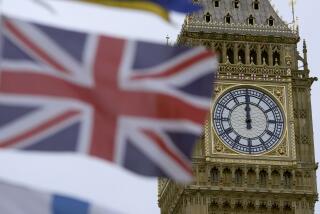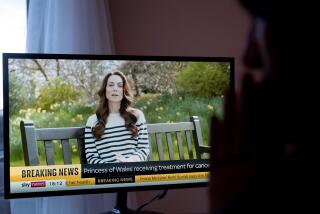A king, or two-buck Chuck?
- Share via
QUEEN ELIZABETH II still rides and is, by all accounts, still active and fit. But she does turn 80 today, so it is not mere morbid voyeurism that puts the succession under scrutiny. Her eldest son, the future Charles III, is being watched very closely.
At 57, Charles is not an enigma, but he is both confused and confusing, well meaning but ham fisted, with a bizarre catalog of eccentricities to his name. His royal head is full of contradictions.
For the record:
12:00 a.m. April 24, 2006 For The Record
Los Angeles Times Monday April 24, 2006 Home Edition California Part B Page 11 Editorial Pages Desk 0 inches; 28 words Type of Material: Correction
Royalty: A commentary Friday about Prince Charles said he is the head of the Church of England. Queen Elizabeth II is the head of the Church of England.
As head of the Church of England, he is, in the Latin, fidei defensor -- defender of the faith -- yet Camilla and Diana were only the latest in a long stream of women (which recent reports say, hilariously, may have included Barbra Streisand) to enjoy his favors. He cheerfully admits on television to having committed adultery.
An enthusiastic champion of environmental causes, he flies to an official appointment in the Czech Republic -- but sends his driver overland in a turbo-charged Bentley (at about 10 miles to the gallon) so he may enjoy his comforts while abroad. He charters commercial jets to take him and his entourage to lecture the dispossessed on eco-accountability.
Though he is deeply conservative in style and traditional in manners, he sells his own line of sausages and organic foods in supermarkets throughout his future realm. He has an abundance of palaces but takes a real interest in the urban underclass.
Although he was the first of his immediate family to go to a university, Charles was never distinguished academically. Not possessed of great speculative intelligence, emotionally constipated and needy, he has looked for mentors and gurus outside both his family and conventional academe.
One such mentor was Laurens van der Post, a South African adventurer, journalist and pop anthropologist whose books and teaching stirred mysticism in the young prince of Wales. Never mind that recent biographies have suggested that Van der Post’s work included a greater imaginative element than would normally be thought appropriate in nonfiction; one nevertheless imagines the two of them spending stirring evenings in front of the campfires discussing the Kalahari bushmen and their concept of the myth of the perpetual return.
Is his eccentricity genetic? Does quirkiness run in the royal DNA? The duke of Windsor, for instance, fed his pugs from custom silver bowls and had servants hand cut his toilet tissue. And Charles’ mother is one of the richest women in the world but insists that her staff walk on the edge of corridor carpets to prevent unnecessary wear.
Charles exists in a universe of neo-feudal privilege. Footmen iron his shorts; valets squeeze his toothpaste. He does not carry cash. It is irresistible to speculate what this might do to a fragile psyche.
If not passed over for one of his sons, Charles may be over 60 when he becomes king, arriving at a position of awesome authority as an immature graybeard.
For now, with his regal future on hold, with the tabloids screaming irreverent headlines about him and his family (such as “Will in Sex and Drugs Scandal”), the man who would be king has busied himself with organic horticulture and, less happily, with architecture.
It is this last that has been most controversial, not least because his family -- while strong on dogs and horses -- has a very dim record in matters of both patronage and appreciation. Asked what she thought of “taste,” the queen once replied: “I don’t think it helps.”
Charles’ interest in architecture seems a mixture of annoying paternalism, small-minded interference and ancien regime snobbismo. Rightly critical of poor housing, he made the error of confusing the bad with the modern, thus giving succor to a comedy team of posturing hacks while damaging the careers of many legitimate architects.
A man keen on period reference, he excoriated the magnificent new British Library because it “looked like a 1930s wireless” without bothering to explain why this was a bad thing. His architectural advisors were a grotesque motley of fogy courtiers and opportunistic Marxist academics, and they’ve left depressing kitsch on the English countryside. Charles’ intervention in architecture was dim and lifeless.
Today, the country’s mood toward its future monarch is one of tolerant exasperation and strained goodwill. When we think about Charles, a decent man tormented by public and private devils comes to mind.
Eighty years ago, when his mother was born, Britain still had late imperial poets doing verse in resonant metrics. It had more than 30 car manufacturers and perhaps as many as 20 companies making aircraft. But that has disappeared.
Charles was born into a rationed, beige, depressed London -- a city exhausted and dispirited. He grew up in a period of post-imperial confusion. But now London is again, and for very different reasons than those Queen Victoria might have understood, a true world city. It is rich, cosmopolitan and exciting; its only authentic rival as a capital of finance, creativity and gastronomy is New York.
Can a prince of Wales who wears Scottish kilts and who does not carry a credit card cope with this new reality?
More to Read
Sign up for our Book Club newsletter
Get the latest news, events and more from the Los Angeles Times Book Club, and help us get L.A. reading and talking.
You may occasionally receive promotional content from the Los Angeles Times.







